Your first blockchain in a matter of minutes using Hyperledger Composer
Table of Contents
In this blog post I would like to show you how easily you can run your first private blockchain based on popular framework for prototyping them called Hyperledger Composer.
In recent years blockchain becomes more and more not only the buzz world but it also growing to be a real solution for some common problems. For the most successful projects are cryptocurrency related, like Bitcoin or Ethereum, but many companies are already investing in other fields, like Walmart in supply chain area, Circulor in tantalum mining, Sony Global Education in education or Visa in international money transfers.
Unlike the Bitcoin, these four exemplary blockchains are private (permissioned) and they work differently than public blockchains (like Bitcoin).
Ok, but first what blockchain really is? #
In short (and I know that it might not give a full picture), blockchain is a network of members where each of them has the same database on their machines, unlike the traditional approach where database is located on a single machine to which users are connecting.
Moreover, it’s not a regular database (ledger). It’s immutable, which means that you can’t modify the record that has been already saved in it. You can only append it or read entries, but don’t update or delete them.
But how each member of a blockchain can have the same database? How it make sure that all users has the same version of it? The answer is by consensus. It’s an algorithm that is needed in blockchain to make an agreement around all parties and keep them synchronized. There are several types of consensuses and each blockchain solutions may implement different kind of it. In Bitcoin it’s Proof of Work and in private blockchain (like in Hyperledger Fabric) it could be Practical Byzantine Fault Tolerance (PBFT) mechanism.
These are not the only attributes of blockchain, for example I’m skipping the cryptography part, but to keep this entry simple I would like to stop right here. If you want to have more comprehensive view on blockchain in general I recommend this review/blog post/video .
The last thing I would like you to know that blockchains can be classified into public and private. Anyone can join a first one, but it’s done anonymously, so nobody knows who all network members are. On the opposite, in private blockchains all users are known to each other and only allowed parties can join it.
Another difference of private (sometimes called permissioned) blockchains is that they allow to restrict activities on a blockchain based on the user roles. In other words each member could have different access rights, for example single member can see only transactions that it’s involved in. And this property makes it very promising for enterprise solutions, where privacy and security plays key role.
Note that some experts claims that private blockchain is not a real blockchain and to some point they’re right, but again, this isn’t a topic of this blog post, but if you want to learn more about pros and cons of public and private blockchain I advice you to read this article.
The Battle Between Public Blockchains vs Private Blockchains | medium.com
Public Vs Private Blockchain In A Nutshell | medium.com
Hyperledger project #
Moving forward with the blog post let’s not focus on how we can create our own blockchain. I would like to show you how you can model a private blockchain and there are several technologies that can help to achieve it. One of them, which I’m going to show you, is Hyperledger Composer which is part of larger ecosystem of the Hyperledger.
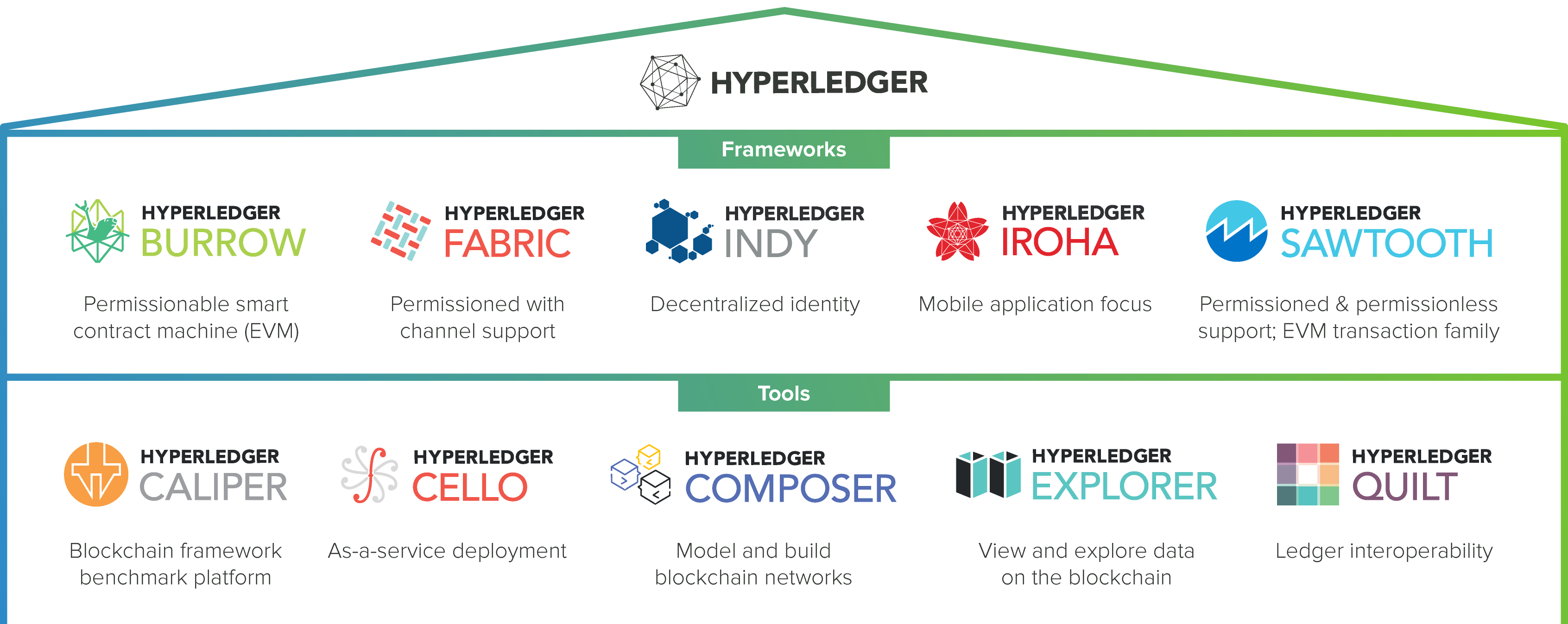
Of course there are several other frameworks available, like JPMorgan’s Quorum, but it looks like that, at least for now, Hyperledger is the leader.
So what is Hyperledger? It’s a huge project that is hosted by The Linux Foundation, the biggest open-source community. It was built by several big companies in 2015 to make first truly production-ready blockchain development platform. Up to date many other companies joined this project, because they see it as the most promising in this area. The more detailed description of Hyperledger could be found in their whitepaper.
As you can see from above picture within Hyperledger there are several tools and frameworks. In this blogpost I’m focusing on Hyperledger Composer, but keep in mind that it’s not a production-ready solution (at least not in June 2019, when I’m writing it) and in my case I’m not creating a real blockchain solution. Hyperledger Composer can be connected with real blockchain, Hyperledger Fabric, but in this tutorial I want to show you a quick way to prototype your blockchain so you’ll get a regular app that can be connected to the real blockchain and then amend it.
Devil’s deals network #
To make it more fun I’ve decided that my network (it’s how in Hyperledger’s slang is called blockchain) could be used by a devil to manage deals that he made with humans. This inspiration came to me after watching Lucifer, TV series.

What will be built? #
So what is the architecture of my solution? I’ve tried to keep it simple, so we have only three types of participants, each one of them with different access rights:
Human — mortals, who needs to make a deal, e.g. to gain some magical powers, immortality, love, wealth, etc.
Devil (or demon) — personification of evil, makes a deal with human and in return he could takes mortal’s soul forever.
Admin — chiefly can do anything 😜.
Each member can do different actions (transactions) on the domain objects (assets) that are defined in the network. And there are three types of them:
Soul — every Human should have it, Devil can collect it after full filing the Deal.
Proposal — every Human can raise it so the Devil can review it and then decide whether to accept, and make a Deal, or reject it. Human can raise as many Proposals as she/he would like.
Deal — only Devil can raise it (using transaction) based on Proposal made by a Human. Each Human can have only one Deal, because in exchange of the Deal Devil will take her/his Soul and that Human can have only one.
And finally here are some actions (transactions) that can be performed and they will be stored in blockchains’ log.
Give a Birth — only admin can raise it and in this transaction Human participant is created with a Soul (admin can still add participant to the network, but she/he needs to remember to create also Soul in separate step).
Reject a Proposal — Devil can do not accept the Proposal raised by a Human.
Make a Deal — only Devil can make this transaction, based on Proposal.
Take a Soul — only Devil can raise it, once a person make a deal Devil& can take person’s Soul depending on the terms of an agreement (e.g. when person dies, do something special). The Soul is added to Devil’s collection.
Apart from that Human can create a Proposal, but in Hyplerledger Composer creation of single asset is not a transaction that needs to be defined explicitly.
The picture that illustrate all actors and assets with possible transaction can be found below.
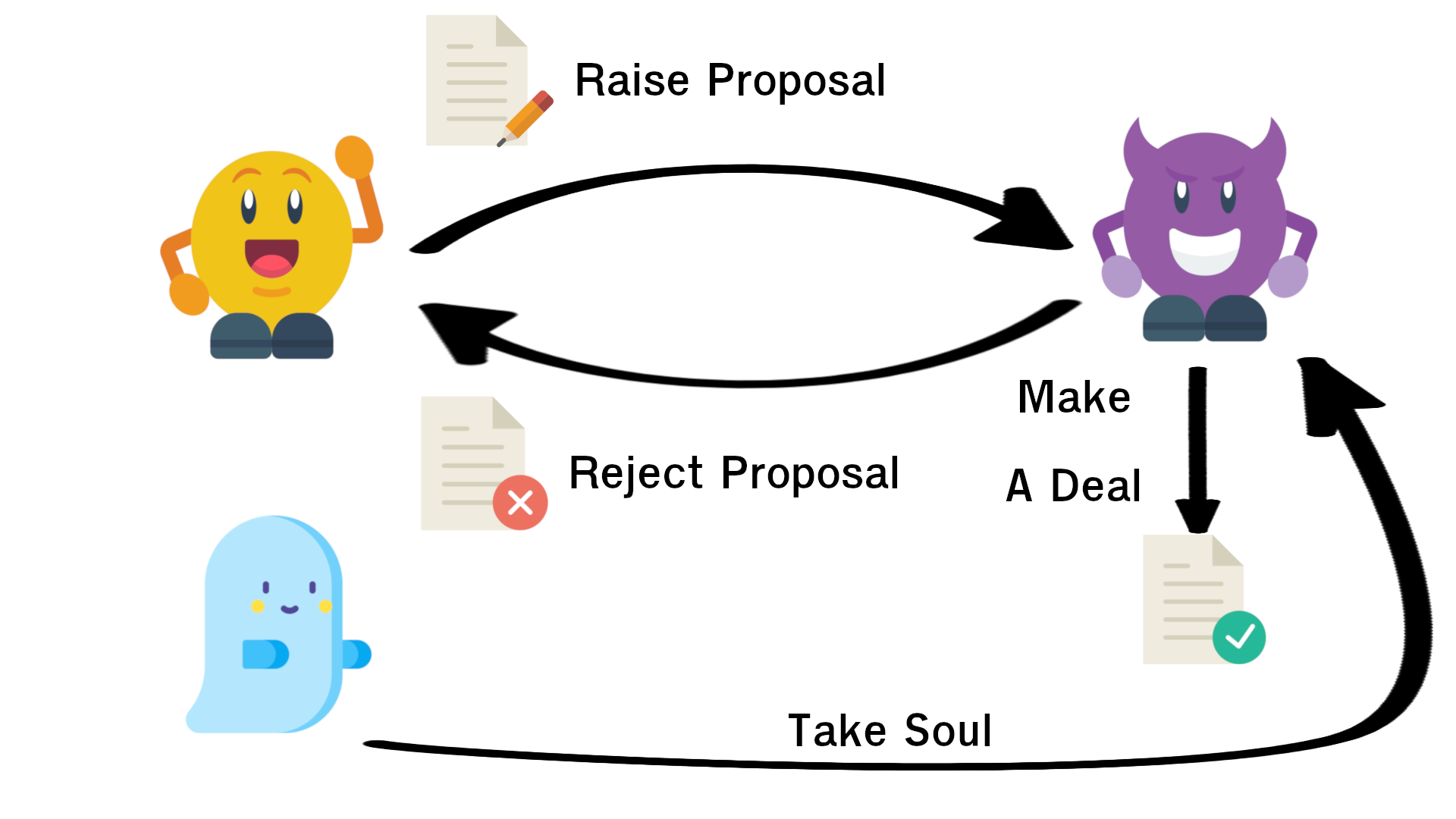
Defining the model #
Finally we can move to the most interesting part — implementing blockchain. All Hyperledger Composer’s projects have specific structure that we need to follow. It contains few files and only three of them are interesting in particular (they are marked with bold font).
devil-deals-network/
├── features/ // ignore this folder right now
│ ├── support/
│ | └── index.js
│ ├── sample.feature
│
├── lib/ // transactions logic
│ └── logic.js
│
├── models/ // members and assets definitions
| └── org.hell.devil.cto
|
├── test/ // unit tests for transactions
| └── logic.js
|
├── .eslintrc.yml // ignore this file right now
├── package.json // key project info and dependencies
├── permissions.acl // access rights definitions
└── README.md // easy to ready file
First, the most important file is located in models folder. As you might already guess it contains the definitions of all objects in the network, which are participants, assets and transactions.
First two participants are pretty straightforward. They are identified by their id, first and last name. Devil also can have a collection of Souls, he also have additional field with the array.
participant Devil identified by devilId {
o String devilId
o String firstName
o String lastName
--> Soul[] souls
}
participant Human identified by humanId {
o String humanId
o String firstName
o String lastName
}
If you wonder what programming language it’s used here — it’s specific Hyperledger Composer’s modeling language.
Next, there are the assets, like Soul, Proposal and Deal. There is also a ProposalStatus which is a enumeration of possible statuses of the Proposal. Some of the assets could be created with default value.
asset Soul identified by soulId {
o String soulId
--> Human human
}
asset Proposal identified by **proposalId** {
o String proposalId
--> Human human
o String favour
o String terms
o ProposalStatus status default = "WAITING_FOR_APPROVAL"
}
enum ProposalStatus {
o WAITING_FOR_APPROVAL
o REJECTED
o ACCEPTED
}
asset Deal identified by dealId {
o String dealId
o DateTime dateTime
--> Human human
--> Devil devil
o String favour
o String terms
o Boolean isFulfilled default = false
}
And finally transactions. Each of them, apart from declaring its name, contains few fields without which it can’t be processed, they’re arguments.
transaction GiveBirthToHuman {
o String humanId
o String firstName
o String lastName
}
transaction RejectProposal {
--> Devil devil
--> Proposal proposal
o DateTime dateTime
}
transaction MakeDeal {
--> Devil devil
--> Proposal proposal
o DateTime dateTime
}
transaction TakeSoul {
--> Devil devil
--> Deal deal
--> Soul soul
o DateTime dateTime
o String description
}
Defying transactions (smart contracts) logic #
Next let’s move on to implementing the logic of each transactions. It can be done in logic.js file which is written in JavaScript.
Each function needs to have a decorator with metadata above the function’s name. It must contains the human readable description of what it is doing, in next line followed by @param which indicates the definitions of the parameter and in the last line there is a @transaction parameter.
In the code you might see objects like AssetRegistry or ParticipantRegistry. They are specific for assigning the Asset or Participant to the variable. More about transaction’s logic can be found in official tutorial or documentation.
'use strict';
/**
* Devil's deals transactions logic
*/
/**
* Admin can give birth to human - flesh and soul are created
* @param {org.hell.devil.GiveBirthToHuman} giveBirth
* @transaction
*/
async function giveBirth(giveBirth) {
var factory = getFactory();
var human = factory.newResource('org.hell.devil', 'Human', giveBirth.humanId);
human.firstName = giveBirth.firstName;
human.lastName = giveBirth.lastName;
let humanRegistry = await getParticipantRegistry('org.hell.devil.Human');
await humanRegistry.add(human);
var soul = factory.newResource('org.hell.devil', 'Soul', giveBirth.humanId);
soul.human = human;
soul.soulId = giveBirth.humanId;
let soulRegistry = await getAssetRegistry('org.hell.devil.Soul');
await soulRegistry.add(soul);
}
/**
* Devil can reject proposal made by human
* @param {org.hell.devil.RejectProposal} rejectProposal
* @transaction
*/
async function rejectProposal(rejectProposal) {
let proposal = rejectProposal.proposal;
proposal.status = "REJECTED";
let proposalRegistry = await getAssetRegistry('org.hell.devil.Proposal');
await proposalRegistry.update(proposal);
}
/**
* Devil can accept proposal made by human
* @param {org.hell.devil.MakeDeal} makeDeal
* @transaction
*/
async function makeDeal(makeDeal) {
let proposal = makeDeal.proposal;
proposal.status = "ACCEPTED";
let proposalRegistry = await getAssetRegistry('org.hell.devil.Proposal');
await proposalRegistry.update(proposal);
let human = proposal.human;
let dealId = human.firstName + ':' + human.lastName + ':' + human.humanId;
var factory = getFactory();
var deal = factory.newResource('org.hell.devil', 'Deal', dealId);
deal.dateTime = makeDeal.dateTime;
deal.human = human;
deal.devil = makeDeal.devil;
deal.favour = proposal.favour;
deal.terms = proposal.terms;
let dealRegistry = await getAssetRegistry('org.hell.devil.Deal');
await dealRegistry.add(deal);
}
/**
* Devil can take human soul to hell after fullfilling the terms of a deal
* @param {org.hell.devil.TakeSoul} takeSoul
* @transaction
*/
async function takeSoul(takeSoul) {
let deal = takeSoul.deal;
deal.isFulfilled = true;
let dealRegistry = await getAssetRegistry('org.hell.devil.Deal');
await dealRegistry.update(deal);
let devil = takeSoul.devil;
let souls = devil.souls;
let soul = takeSoul.soul;
if (typeof souls === 'undefined') {
souls = new Array();
}
souls.push(soul);
devil.souls = souls;
let devilRegistry = await getParticipantRegistry('org.hell.devil.Devil');
await devilRegistry.update(devil);
}
Defying permissions #
Finally we can specify access rights of both participants. By design Human and Devil could perform different actions. For example, Human can raise a Proposal, but could not create a Deal.
/**
* Access control list of Devil's Deal network.
*/
rule DevilReadAndUpdateAccessToOwnProfile {
description: "Allow devil to read access to her/his profile info"
participant(p): "org.hell.devil.Devil"
operation: UPDATE, READ
resource(r): "org.hell.devil.Devil"
condition: (p.getIdentifier() === r.getIdentifier())
action: ALLOW
}
rule DevilCanReadEverything {
description: "Allow Devil to read access to all resources"
participant: "org.hell.devil.Devil"
operation: READ
resource: "org.hell.devil.*"
action: ALLOW
}
rule DevilCanRejectProposalTransaction {
description: "Allow Devil to reject Proposal"
participant(p): "org.hell.devil.Devil"
operation: ALL
resource(r): "org.hell.devil.RejectProposal"
condition: (p.getIdentifier() === r.devil.getIdentifier()
&& r.proposal.status === "WAITING_FOR_APPROVAL")
action: ALLOW
}
rule DevilMakeDealTransaction {
description: "Allow Devil make a Deal with human based on Proposal"
participant(p): "org.hell.devil.Devil"
operation: ALL
resource(r): "org.hell.devil.MakeDeal"
condition: (p.getIdentifier() === r.devil.getIdentifier()
&& r.proposal.status === "WAITING_FOR_APPROVAL")
action: ALLOW
}
rule DevilCanModifyProposal {
description: "Allow Devil to modify Proposal"
participant: "org.hell.devil.Devil"
operation: UPDATE
resource: "org.hell.devil.Proposal"
action: ALLOW
}
rule DevilCanModifyDeal {
description: "Allow Devil to modify Proposal"
participant: "org.hell.devil.Devil"
operation: ALL
resource: "org.hell.devil.Deal"
action: ALLOW
}
rule DevilCanTakeSoulTransaction {
description: "Allow Devil to TakeSoul transaction"
participant(p): "org.hell.devil.Devil"
operation: ALL
resource(r): "org.hell.devil.TakeSoul"
condition: (p.getIdentifier() === r.devil.getIdentifier())
action: ALLOW
}
rule HumanReadAndUpdateAccessToOwnProfile {
description: "Allow human to read access to her/his profile info"
participant(p): "org.hell.devil.Human"
operation: UPDATE, READ
resource(r): "org.hell.devil.Human"
condition: (p.getIdentifier() === r.getIdentifier())
action: ALLOW
}
rule HumanReadAccessToDevilAndDeamonsList {
description: "Allow human to know devil participant list"
participant: "org.hell.devil.Human"
operation: READ
resource: "org.hell.devil.Devil"
action: ALLOW
}
rule HumanCanCreateAndReadOwnProposal {
description: "Allow human to make a proposal"
participant(p): "org.hell.devil.Human"
operation: CREATE, READ
resource(r): "org.hell.devil.Proposal"
condition: (p.getIdentifier() === r.human.getIdentifier())
action: ALLOW
}
rule SystemACL {
description: "System ACL to permit all access"
participant: "org.hyperledger.composer.system.Participant"
operation: ALL
resource: "org.hyperledger.composer.system.**"
action: ALLOW
}
rule NetworkAdminUser {
description: "Grant business network administrators full access to user resources"
participant: "org.hyperledger.composer.system.NetworkAdmin"
operation: ALL
resource: "**"
action: ALLOW
}
rule NetworkAdminSystem {
description: "Grant business network administrators full access to system resources"
participant: "org.hyperledger.composer.system.NetworkAdmin"
operation: ALL
resource: "org.hyperledger.composer.system.**"
action: ALLOW
}
In general, there are two types of access right rules with and without condition. First ones are more general, they are applied to all users. For example the rule HumanReadAccessToDevilAndDeamonsList tells that all Humans can see whole list of Devils, no matter to which one they had raised Proposal before.
Later type of access right contains a condition and usually it’s used to stress out that a particular user can only see her/his own assets. For example, rule HumanCanCreateAndReadOwnProposal covers that Human can raise a Proposal only for herself/himself and can only see own Proposals.
More about Hyperledger Composer’s Access Control Language can be found in documentation.
Running the Playground #
Prerequisites. In order to follow my instructions you need to have installed two tools: git and Docker. First one is a version control system and could be downloaded from here. Second is a container tool for packaging app so they can be ran anywhere. If you don’t have Docker go check out one of the following instructions for Ubuntu, Windows or Mac.
Now let’s run a Playground environment. To keep it simple, so you don’t need to install any Hyperledger Composer tools, I’ve decided to download Docker image with predefined environment (still, if you want to have installed all necessary tools on your machine go check official documentation).
To run the environment with a container open terminal app and type:
docker run --name composer-playground --publish 8080:8080 --detach hyperledger/composer-playground
Above command will download and run the composer-playground Docker file.
After the above command has finished go to the web browser and type localhost:8080, so the web Playground will open.
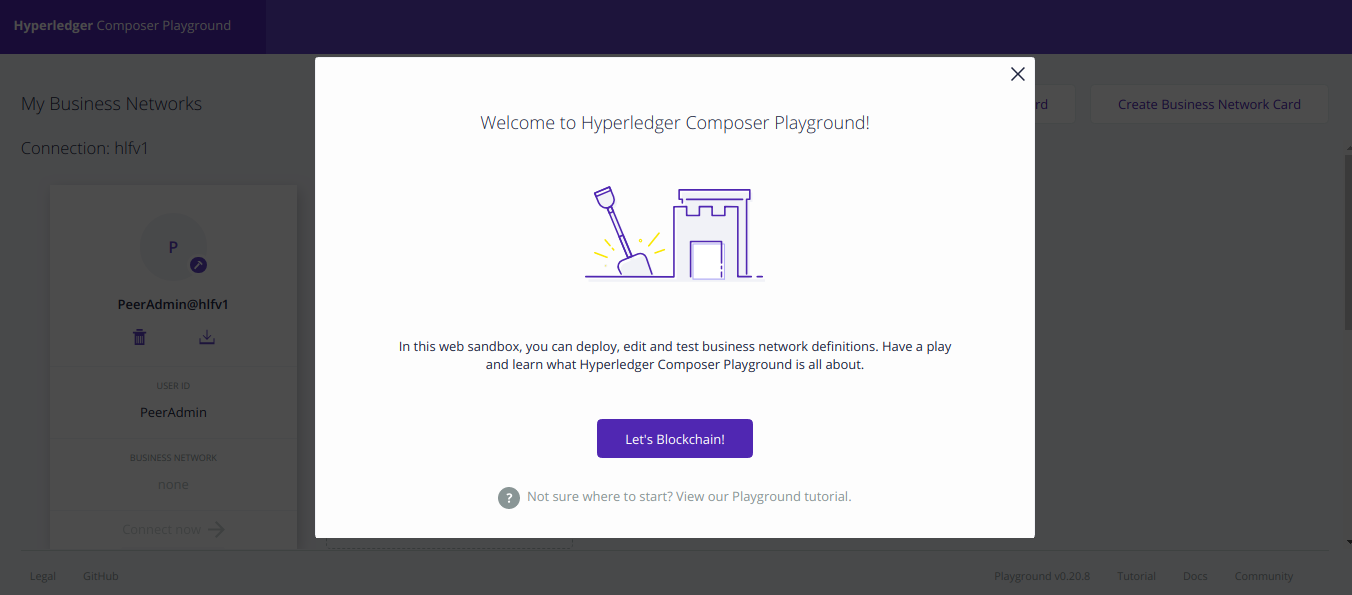
If so, that’s great! Now git clone this project using the command:
git clone https://github.com/wkrzywiec/devil-deals-network.git
After that you should have devils-deals-network@0.0.1.bna that can be deployed to the Hyperledger Composer Playground. To do so, go back to Playground in your web browser and then click Deploy a new business network.
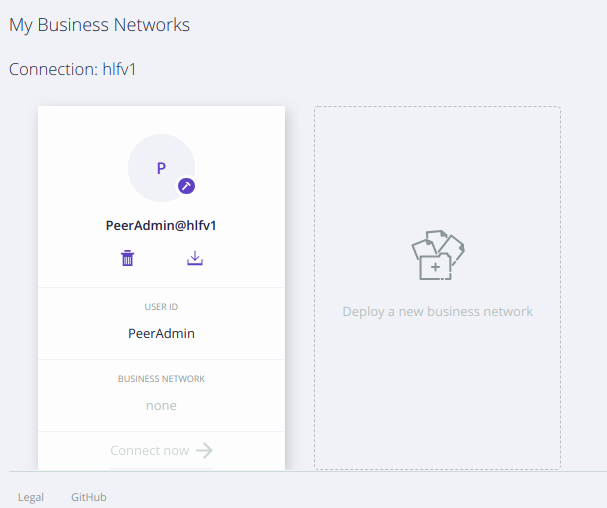
There scroll down to the section where you can drop or browse the file to upload.

After choosing the file click Deploy button on the right side.

This blockchain was successfully deployed!

If you happen to stop the container (in e.g. when turning off your PC) you can rerun it with command:
docker start --interactive composer-playground
Play around with blockchain #
Blockchain is deployed now, so let’s add some transactions!
First we need to login as an admin and create two user accounts — one for a devil and one for a human. Therefore go to the main page where will be a business connection card for an admin. At the bottom, there is Connect now link.
Then, go to Test (at the top of the page) and click Create New Participant icon at the top right corner.

First we create a devil’s account, where we need to provide devilId (it’s generated automatically, but I advise to type your own, that will be better to remember), firstName and lastName. After providing it click Create New button.
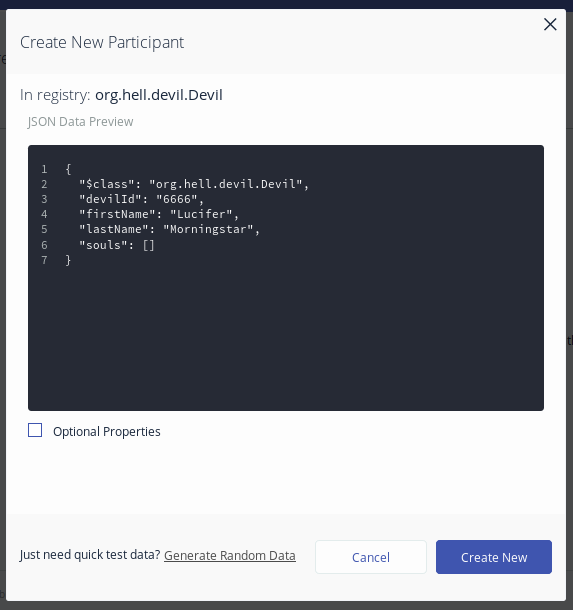

Next, we need to create Human account. It could be done similarly to the devils’, but it would require to create also a Soul in separate step. Therefore to do it in one step, click on Submit Transaction button at the bottom left.
It’ll open similar window as for creating a devil participant but in this case make sure that from the drop down list GiveBirthToHuman is picked. And then provide similar data as for a devil and click Submit.
For this demo, I’ll replicate to the polish legend about a man, Pan Twardowski, who made a bargain with a devil.
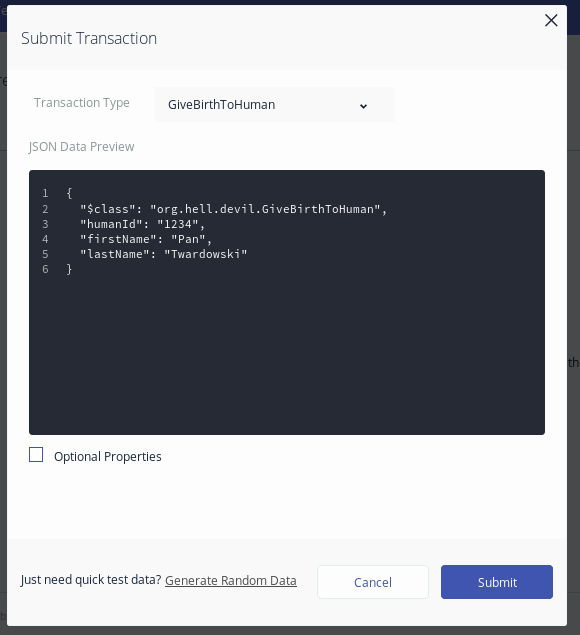
Once both users are created and saved on blockchain, let’s create network business cards, which allows them to login. To do that go to admin (at the top right corner) and from the list pick ID Registry. On a new page click Issue New ID and in a pop-up window, in a field Participant, start typing devil’s ID so the list of available users will appear. Then provide username in the ID Name field and apply it by clicking Create New button.
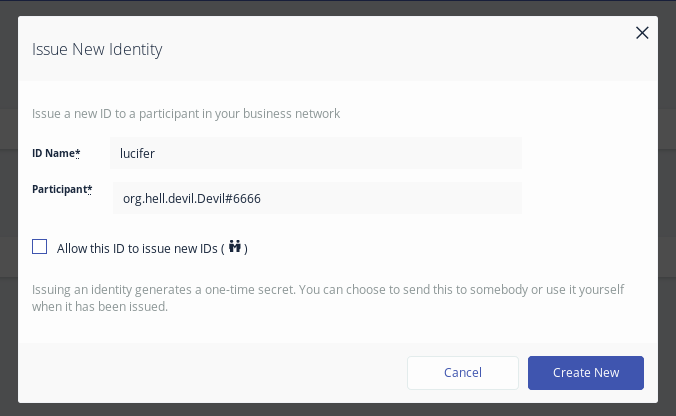
Same steps repeat for Pan Twardowski’s account. After that, on the same page, there is a list of available users and from it pick Human’s account by clicking Use Now button when you hover on it’s label.

We’re logged as a Human so now we would like to raise a Proposal by clicking on Proposal icon on the left panel and then by clicking the +Create New Asset button at the top right corner. In new window provide proposalId, human (Twardowski’s Id), description of a favour and terms when soul could be taken to hell.

Proposal was saved, so now we should switch to devil’s user. Once you’re logged as a devil you can submit a new transaction RejectProposal or MakeDeal. I choose to go with latter one. An input for a transaction are ids of a devil and Proposal.
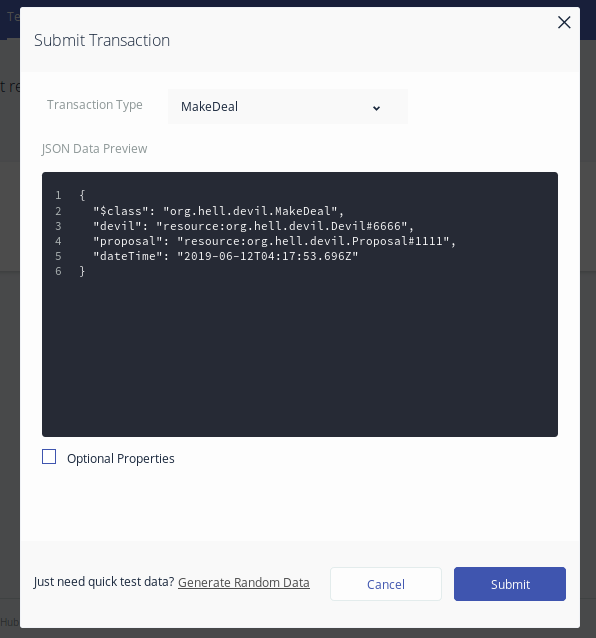
Deal has been done, Proposal has changed status to accepted and also all details from it has been copied to the Deal. To check that go to Deal’s asset tab (left menu).

And finally, still logged as a devil, we can submit TakeSoul transaction.

After this transaction Deal’s field isFuillfield is now true and Devil’s account contains first Soul.

If you want to check the history log (the ledger) for this blockchain go to All Transactions tab (left menu).

This was a simple example of how you can play around with my blockchain. If you want go check other scenarios like rejecting the Proposal or raising a Deal without it (which is not possible).
How to create you own blockchain? #
If you’ve made it to reach this point, you’re probably eager to know how to create your own blockchain. You can modify mine, if you want, by clicking Define button at the top bar, where are all files that define assets, transactions logic and permission rules. You can adjust them as you want and then redeploy it to test them.
Another way would be to create your own network from scratch or from prepared samples. Both options are available from Deploy New Business Network site which is available under http://localhost:8080/login?ref=web-%24default#deploy.
If you want more insight on all capabilities of Hyperledger Composer go to the official documentation site.
Introduction | Hyperledger Composer | hyperledger.github.io
Full code of my project is available on GitHub:
wkrzywiec/devil-deals-network | github.com
